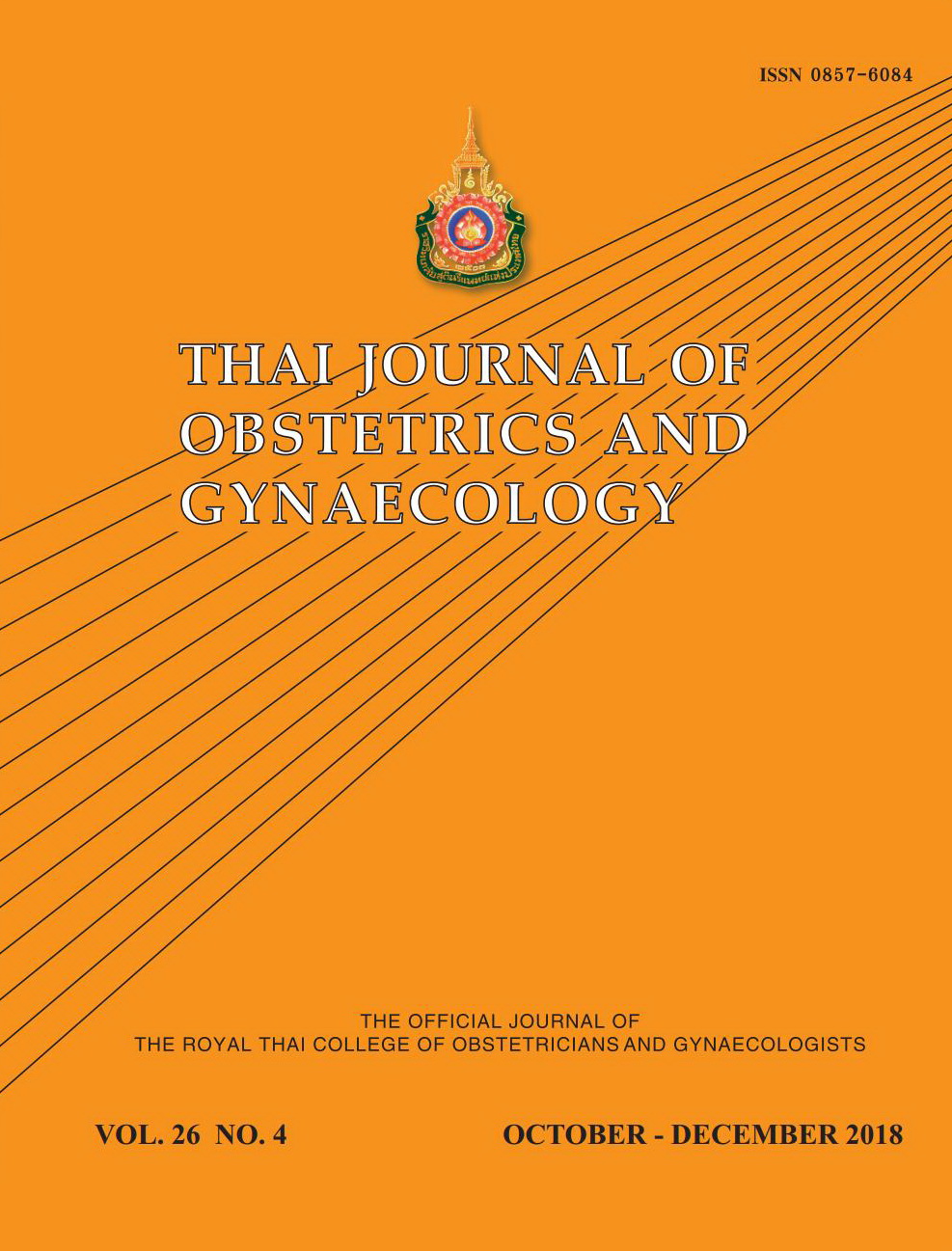Prognostic Factors and Survival Rates in Early-stage Cervical Cancer Patients Treated with Radical Hysterectomy and Pelvic Lymphadenectomy
Main Article Content
Abstract
Objectives: To evaluate prognostic factors and survival rates in early-stage cervical cancer patients who had been treated with radical hysterectomy and pelvic lymphadenectomy (RHPL).
Materials and Methods: Medical records and pathologic findings of 177 cervical cancer patients who had International Federation of Gynecology and Obstetrics (FIGO) stage IA2-IIA and underwent RHPL at Buddhachinaraj Phitsanulok Hospital from January 2005 to December 2016 were retrospectively reviewed. Clinicopathologic variables and treatment data were collected.
Results: Among 177 patients, mean age was 49.9 ± 11.0 years. The median follow-up time was 42 months. Twenty-five patients had a recurrence and 7 patients died from disease. A five-year disease free survival (DFS) rate and a 5-year cancer-specific survival (CSS) rate were 89% and 96.6%, respectively. The independent prognostic factors for DFS were increasing age and pelvic lymph node metastasis (hazard ratio [HR] 1.06; 95%CI 1.02-1.10, and HR 4.63; 95%CI 1.21-17.64, respectively). No significant differences in FIGO stage, histology, positive surgical margin, parametrial involvement, pelvic lymph node metastasis, deep stromal invasion, lymph vascular space invasion, and tumor size were identified as independent prognostic factors for CSS. However, adenocarcinoma (AC) patients with parametrial involvement, pelvic lymph node metastasis, and postoperative treatment followed by concurrent chemoradiotherapy (CCRT) had a significantly worse survival outcome than those with squamous cell carcinoma (SCC) (HR 11.87; 95%CI 1.46-46.20, HR 7.00; 95%CI 1.55-31.66, and HR 7.20; 95%CI 1.57-32.85, respectively).
Conclusion: Early-stage cervical cancer patients who underwent RHPL showed good survival rates. The independent prognostic factors for DFS were increasing age and pelvic lymph node metastasis whereas no prognostic factors for CSS were found. Furthermore, parametrial involvement, pelvic lymph node metastasis, and postoperative treatment followed by CCRT were likely to be predictors for poorer survival outcomes in AC than those in SCC.
Keywords: cervical cancer, prognostic factor, survival, radical hysterectomy
Article Details
References
2. Ferlay J, Soerjomataram I, Dikshit R, Eser S, Mathers C, Rebelo M, et al. Cancer incidence and mortality worldwide: sources, methods and major patterns in GLOBOCAN 2012. Int J Cancer 2015;136:E359-86.
3. Torre LA, Bray F, Siegel RL, Ferlay J, Lortet-Tieulent J, Jemal A. Global cancer statistics, 2012. CA Cancer J Clin 2015;65:87-108.
4. Imsamran W, Chaiwerawattana A, Wiangnon S, Pongnikorn D, Suwanrungrung K, Sangrajrang S, et al. National Cancer Institute Thailand. Cancer in Thailand: Vol. VIII, 2010-2012. 2015;8:5-12.
5. Brucker SY, Ulrich UA. Surgical Treatment of Early-Stage Cervical Cancer. Oncol Res Treat 2016;39:508-14.
6. American Cancer Society. Treating cervical cancer 2016:3-9.
7. American Cancer Society. Cervical cancer early detection, diagnosis, and staging 2016:13-5.
8. Ayhan A, Al RA, Baykal C, Demirtas E, Ayhan A, Yuce K. Prognostic factors in FIGO stage IB cervical cancer without lymph node metastasis and the role of adjuvant radiotherapy after radical hysterectomy. Int J Gynecol Cancer 2004;14:286-92.
9. Kasamatsu T, Onda T, Sawada M, Kato T, Ikeda S. Radical hysterectomy for FIGO stage IIB cervical cancer: clinicopathological characteristics and prognostic evaluation. Gynecol Oncol 2009;114:69-74.
10. Lee YY, Choi CH, Kim TJ, Lee JW, Kim BG, Lee JH, et al. A comparison of pure adenocarcinoma and squamous cell carcinoma of the cervix after radical hysterectomy in stage IB-IIA. Gynecol Oncol 2011;120:439-43.
11. Park JW, Bae JW. Prognostic significance of positive lymph node number in early cervical cancer. Mol Clin Oncol 2016;4:1052-6.
12. Pecorelli S. Revised FIGO staging for carcinoma of the vulva, cervix, and endometrium. Int J Gynaecol Obstet 2009;105:103-4.
13. Rudtanasudjatum K, Charoenkwan K, Khunamornpong S, Siriaunkgul S. Impact of histology on prognosis of patients with early-stage cervical cancer treated with radical surgery. Int J Gynaecol Obstet 2011;115:183-7.
14. Ruengkhachorn I, Therasakvichya S, Warnnissorn M, Leelaphatanadit C, Sangkarat S, Srisombat J. Pathologic Risk Factors and Oncologic Outcomes in Early-stage Cervical Cancer Patients Treated by Radical Hysterectomy and Pelvic Lymphadenectomy at a Thai University Hospital: A 7 year Retrospective Review. Asian Pac J Cancer Prev 2015;16:5951-6.
15. Tantitamit T, Hamontri S. Surgical Outcomes and Prognostic Factors in Cervical Cancer: A 12 year, Single-Center Experience. Asian Pac J Cancer Biol 2017;2:67-72.
16. Singh P, Tripcony L, Nicklin J. Analysis of prognostic variables, development of predictive models, and stratification of risk groups in surgically treated FIGO early-stage (IA-IIA) carcinoma cervix. Int J Gynecol Cancer 2012;22:115-22.
17. Nakanishi T, Ishikawa H, Suzuki Y, Inoue T, Nakamura S, Kuzuya K. A comparison of prognoses of pathologic stage Ib adenocarcinoma and squamous cell carcinoma of the uterine cervix. Gynecol Oncol 2000;79:289-93.
18. Grisaru DA, Covens A, Franssen E, Chapman W, Shaw P, Colgan T, et al. Histopathologic score predicts recurrence free survival after radical surgery in patients with stage IA2-IB1-2 cervical carcinoma. Cancer 2003;97:1904-8.
19. Horn LC, Fischer U, Raptis G, Bilek K, Hentschel B. Tumor size is of prognostic value in surgically treated FIGO stage II cervical cancer. Gynecol Oncol 2007;107:310-5.
20. Horn LC, Bilek K, Fischer U, Einenkel J, Hentschel B. A cut-off value of 2 cm in tumor size is of prognostic value in surgically treated FIGO stage IB cervical cancer. Gynecol Oncol 2014;134:42-6.
21. National Comprehensive Cancer Network. NCCN clinical practice guidelines in oncology cervical cancer 2016:11-34.
22. Mabuchi S, Okazawa M, Matsuo K, Kawano M, Suzuki O, Miyatake T, et al. Impact of histological subtype on survival of patients with surgically-treated stage IA2-IIB cervical cancer: adenocarcinoma versus squamous cell carcinoma. Gynecol Oncol 2012;127:114-20.
23. Kasamatsu T, Onda T, Sawada M, Kato T, Ikeda S, Sasajima Y, et al. Radical hysterectomy for FIGO stage I-IIB adenocarcinoma of the uterine cervix. Br J Cancer 2009;100:1400-5.
24. Winer I, Alvarado-Cabrero I, Hassan O, Ahmed QF, Alosh B, Bandyopadhyay S, et al. The prognostic significance of histologic type in early stage cervical cancer - A multi-institutional study. Gynecol Oncol 2015;137:474-8.
25. Kodama J, Seki N, Masahiro S, Kusumoto T, Nakamura K, Hongo A, et al. Prognostic factors in stage IB-IIB cervical adenocarcinoma patients treated with radical hysterectomy and pelvic lymphadenectomy. J Surg Oncol 2010;101:413-7.


